Salt-tolerant crops
Salt-tolerant crops can tolerate a certain amount of salt without compromising production or quality. Growing salt-tolerant crops offers the solution for continuous production in an increasingly saline environment.
|
Thema |
Zoetwatervoorziening, Delta facts, English versions |
|
Tags |
|
|
Downloads |
- INTRODUCTION
- RELATED TOPICS AND DELTA FACTS
- STRATEGY: HOLD, STORE, SUPPLY
- SCHEMATIC
- PERFORMANCE
- COSTS AND BENEFITS
- TECHNICAL SPECIFICATIONS
- GOVERNANCE
- FIELD EXPERIENCE (NATIONAL AND INTERNATIONAL)
- CURRENTLY ACTIVE PROJECTS AND RESEARCH
- KNOWLEDGE GAPS
- OVERVIEW CURRENTLY ACTIVE PROJECTS AND RESEARCH
Introduction
Increasing scarcity of good quality water is a major problem for agriculture, and with salinity rising worldwide, the most obvious solution is to grow more salt-tolerant crops. Salt-tolerant crops can tolerate a certain amount of salt without compromising production or quality. Growing salt-tolerant crops offers the solution for continuous production in an increasingly saline environment.

In other countries, especially in arid regions, salinity often occurs when salts accumulate in the root zone of plants due to reduced water movement. In the Netherlands and similar deltas, the main source of salinity is seawater, which contains about 24g of natrium chloride (NaCl) per kg of seawater. This fact sheet addresses salinity by seawater in the Netherlands, with emphasis on NaCl, which is further referred to as ‘salt’. Research in this area has long been on the backburner in the Netherlands, but a host of new publications and interesting developments has reinvigorated the research effort. The salt-tolerance of some crops is seemingly higher than often assumed, allowing for more room for action in agriculture and water management.
Related topics and Delta Facts
Topics: fresh water need, salinity, climate adaptation, work with natural processes, brackish seepage, saline water irrigation.
Delta facts: This topic is related to the following Delta Facts:
- Brackish seepage
- Soil moisture-based irrigation
- Drought determines functions
- Dynamic water level management
- Effects of climate change on agriculture
- Effects of salinity on fresh water aquatic ecosystems
- Effectiveness of water intake
- Aquifer storage and recovery
- Controlled drainage
- Robustness of fresh water
- Company water reservoirs
Strategy: hold, store, supply
Cultivation of salt-tolerant crops presents an option for entrepreneurs. Not a strategy as in the sense of the three water strategies 'hold, store and supply', it is instead a strategy to adapt land use to the trends and seasonal variations in salinity of the soil water.
As climate change manifests itself in more extreme weather events such as hotter summers and more frequent and severe droughts, demand for water will increase as supply decreases. The low priority of Agriculture on the Priority List (National Water Plan 2009-2015, Ministry of Infrastructure and the Environment, 2009) renders the supply of water for agriculture and horticulture by the water manager uncertain. As the risk of salinity increases, the strategy of transitioning from conventional crops to salt-tolerant crops moves into the categories 'work with natural processes' and 'seize opportunities' in the National Water Plan 2009-2015: 'work with natural processes where possible, improve resilience where necessary, and seize opportunities for prosperity and well-being'.
Having a proper understanding of the salt-tolerance of crops is essential in both strategies: “improve resilience” refers to the salt-tolerance of the current crop pattern, “work with natural processes” primarily refers to the choice of crops in the saline regime to be expected.
Schematic
Knowledge about dealing with salt in agriculture has been built up over hundreds of years in the Netherlands. The need for building empirical and scientific knowledge arose as a result of the frequent inundation of agricultural lands by seawater. After WWII, American expertise was combined with experiences from Dutch field trials. Since the PAWN studies from the early 80s (Abrahamse, 1982), the yield reduction of agricultural crops is often calculated using a simple methodology developed in the US. This methodology assumes a linear correlation between decrease in crop yield and an above-threshold increase in salt concentration (Figure 1).
The threshold value at which the yield starts to decrease and the rate of decrease differs from crop to crop. This method is simple and used widely in the Netherlands and beyond.
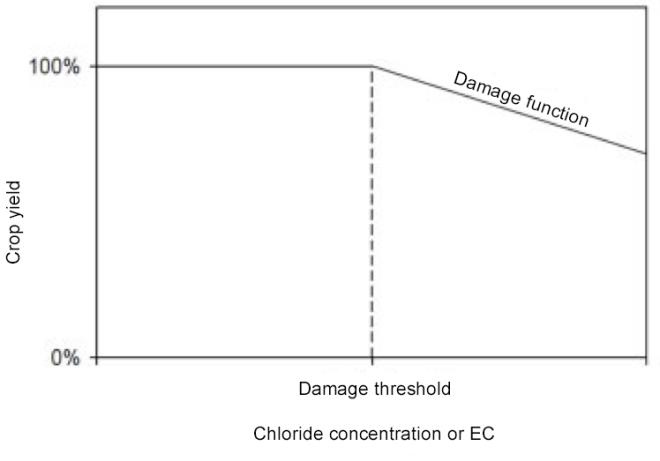
- Figure 1. Crop yield as a function of increasing salt concentration (from: Dam et al., 2007).
Performance
How does salt-induced crop damage occur?
Salt tolerance of crops depends on the crop type and variety, as well as the soil moisture composition. Salt concentrations have an osmotic and ionic effect. Roots absorb water and dissolved nutrients (or solutes) from the soil by lowering the water potential of the cells, thereby facilitating the flow of water to the roots; this process is known as osmosis. High salt concentrations lower the water potential of the soil surrounding the roots. The water potential difference observed between the soil and roots decreases as the salt concentrations in the soil water increase, and reduce water uptake. This effect is similar to drought.
The ionic effect indicates the toxic effect of some ions at high concentrations in the plant. Figure 2 shows an example of barley, where sodium has a very adverse effect on the plant’s development.
The sources of salt for soil water are: 1) precipitation and irrigation from the top, 2) seepage from the bottom, and 3) surface water from the sides. In general, our precipitation surplus and well-drained lands help flush out excess salts and prevent salt build-up. Proper drainage is essential. It would be an entirely different proposition if it were dry and irrigation was required, or if other forms of water supply, such as sub-infiltration with brackish water, were used to prevent drought.
At present, irrigation is the main source of salt damage to most crops. For farmers, it usually comes down to choosing between the lesser of two evils: crop damage from saline irrigation water or drought.
Crops can also sustain foliar damage caused by salt build-up from irrigation; the heat released from irrigation water creates very hot and dry conditions that prevent evaporation and cause leaf damage. Droplets of salt can dry on the leaves and act as heat-transmitting lenses that burn the leaf. Indirect damage to crops can also be caused by structural soil degradation (see, for example, Snellen et al., 2012, for a historical overview).
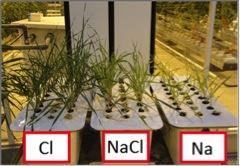
- Figure 2. Snapshot of crop development as a result of three treatments with the same level of salt, but no potentially toxic sodium (treatment with CI) or chloride (treatment with Na), or when the salt is almost entirely determined by table salt (NaCl). Source: Van der Zee, 2013
How salt-tolerant are crops?
Crop type and variety are important determining factors for the salt tolerance of crops. Breeders are exploring ways to find salt-tolerant varieties, especially for regular crops like potatoes and winter wheat. Various field experiments conducted over the years on Texel by the Zilt Proefbedrijf (http://www.ziltproefbedrijf.nl/) clearly show that significant salt-tolerance differences can occur from one variety to another (Levy et al., 2013; Vos, in prep). Table 1 shows the salt sensitivity classes and target values for chloride concentrations in irrigation water for various crops grown in the Netherlands (Stuyt & Van Bakel, 2011).
| Land use | Salt-sensitivity class | Target value for chloride concentration in irrigation water (mg/l) |
| Grass | tolerant | 2400 |
| Beets | tolerant | 2400 |
| Potatoes | moderately tolerant | 600 |
| Other agriculture | sensitive | 300 |
| Flower bulbs | sensitive | 300 |
| Tree nursery (not container cultivation) | sensitive | 300 |
| Fruit nursery | sensitive | 300 |
| Greenhouse horticulture (not substrate cultivation) | very sensitive | 150 |
Table 1. Salt sensitivity classes and target values for chloride concentrations in irrigation water for various crops grown in the Netherlands. Source: Stuyt & van Bakel, 2011.
In a study by Alterra, a salt-sensitivity class, including target values for the chloride concentration in the irrigation water (Table 1), is assigned to each form of agricultural land use where irrigation takes place and which comprises more than 5% of the total area of a drainage unit in that area. It should be noted that chloride content is not an ideal indicator because aside from osmotic effects, salt damage, specifically due to high concentrations of the Na+ ion, can also be a determining factor. These effects include toxic effects and possible structural degradation of the clay soil.
Salt damage can occur when concentrations exceed the target values, hence these are the maximum concentrations that are accepted by agriculture. The most sensitive crop in each drainage unit is shown on the map in Figure 3. Where two or more crops are in the same sensitivity class, the crop in the largest area within the drainage unit is taken as indicator.
How does it work?
Viewed from the perspective of the water manager, both ground and surface water contain salts that can cause direct or indirect problems in crops. Groundwater can be an important source in regions affected by local seepage. De Louw (2013) showed that 50% of the salt load in the Noordplas polder comes from wells. This is a local seepage, a point source where groundwater floats upwards at local points in a weak spot in the layer of clay, e.g. in a ditch or an excavated spot on the plot. In addition, there may be diffuse seepage from saltwater on an agricultural plot below sea level. This diffuse source generally causes less salt problems, because water and salt are discharged via the drainage system. For irrigation, choosing a suitable water source (basins, ground or surface water) is a critical first step.
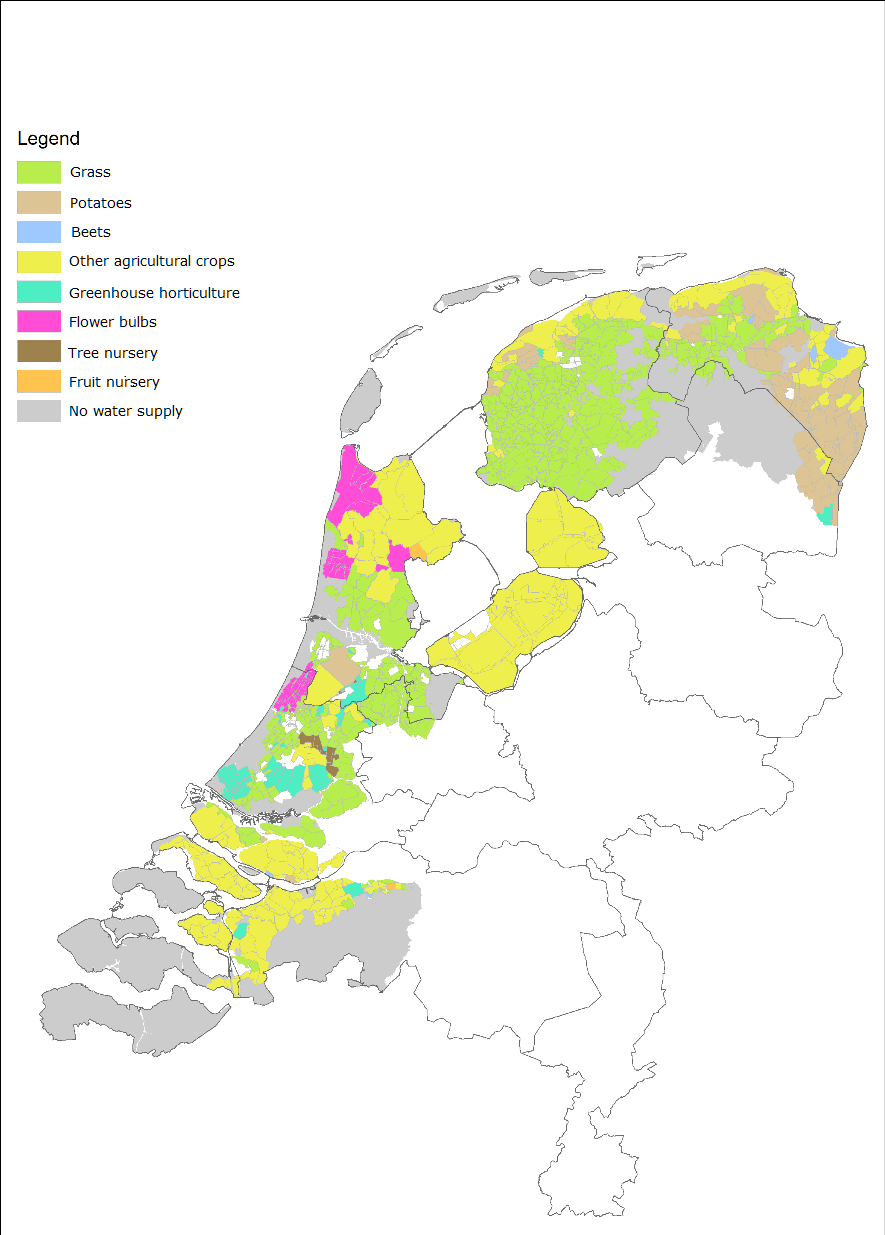
Figure 3. Most salt-sensitive crop in each drainage unit (Source: Stuyt & van Bakel, 2011)
What stands out?
Choosing between salt damage and drought damage is difficult in practice. Field trials performed on Texel by the Zilt Proefbedrijf show that the salt tolerance of potatoes can vary greatly from one variety to another, and that salt sensitivity is usually a combination of heat and salt stress, a finding which is in line with international literature (Bustan et al., 2004). Literature also shows that salt has different effects on different parts of the potato crop; the tuber yield stays practically the same as salt concentrations increase, while the dry-matter production in other parts decreases (Figure 4).
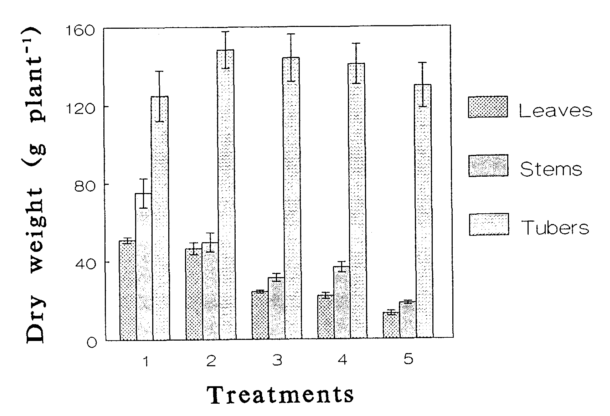
Figure 4. The effect of increasing salt concentrations on the dry matter content in potatoes. Source: Nadler & Heuer (1995).
Saltwater crops
Some salt-tolerant plants, or halophytes, are capable of thriving in highly saline environments (Rozema and Flowers, 2008). Saltwater crops, such as some cabbage types, which receive specific attention at the Zilt Proefbedrijf on Texel, also offer potential as demonstrated by De Vos (2011) in his thesis. Cultivation of glasswort has also been the object of studies in recent years, and is currently grown commercially on a small scale (Blom & Visser, 2013). These crops are still a niche market. Development of salt-tolerant varieties of conventional land-based crops has seemingly gained traction in a short time (Stuyt et al., in prep).
Costs and benefits
For the regional water manager:
When agricultural entrepreneurs opt for more salt-tolerant crops in their business plan (crop choice, growing plan), their yields will be less dependent on fluctuations and trends in the salinity of soil and irrigation water. The water manager can therefore control or adjust - within wider bandwidths and in a more cost-effective and flexible manner - the desired salinity of the surface water used for irrigation. The benefits of a more flexible approach to salinity control or adjustment are linked to the various functions that the water system performs for different users (agriculture, industry, drinking water) and the best-efforts obligations that the water manager has in respect of nature and water quality. The choice of more salt-tolerant crops in agriculture falls within the 'Work with natural processes' category in the national water plan.
For the entrepreneur:
Transition to other crops will initially entail additional costs for entrepreneurs, which may include plot development and preparation costs. Other arrangements may also need to be made with new or existing customers of the crops, which requires time investment. Transition to more salt-tolerant crops, such as potatoes or flower bulbs, is the most cost-effective option, as the entrepreneur will be able to build on his cropping experience in the sector. Plus, a market already exists for the crop. Transition to other (more salt-tolerant) crops requiring further land development, preparation, drainage and irrigation entails greater investment costs and risks. The biggest investment risk involves transitioning to a ‘new’ salt-tolerant crop (e.g. glasswort) that has yet to gain ground with consumers. This is seemingly difficult in the case of glasswort (Stuyt et al., 2006). The benefits lie in the fact that over time, the entrepreneur can develop a growing plan with a more stable economic return that is less dependent on fluctuations in salinity.
It is furthermore expected that, based on the commitments made by the government, companies that have recently made investments to specialise in high-value crops and are therefore highly dependent on a guaranteed supply of fresh water of sufficient quantity and quality, will seek financial compensation for that purpose. Research institutes can also invest in developing knowledge needed for transition and management from the new perspective.
Technical specifications
Improve resilience. The main condition is a guaranteed supply of fresh water.
Work with natural processes. The main condition is to generate enough sales for the products from saltwater crops. Because of the added value, options are being explored to market the products as 'local products'. In the Southwest Delta, initiatives are underway to develop a landscape that is attractive to the discerning tourist (see, for example, Back to shore: New market alliances for tourist area development in the Delta). (Large-scale) cultivation of halophytes may very well have a future, but that requires a transition (Stuyt et al., 2006; De Vos et al., 2011).
Governance
The National Water Plan 2009-2015 provides that both options 'work with natural processes' and 'improve resilience' are possible. The 'improve resilience' option is highly dependent on government investment in the supply of fresh water. With the 'work with natural processes’ option, expenses are largely borne by the companies. The 'work with' option is not incentivised by the current compensation scheme for salt damage. This also applies to the current low rates for water supply. To make the 'work with' option a realistic option, the compensation scheme for salt damage should be abolished and replaced by a differentiated service for the delivery of fresh water, with rates that depend on the water quality and security of supply.
Field experience (national and international)
International experience in dealing with saltwater in agriculture is mainly gained in irrigation practices in arid countries. About 20-25% of the total global irrigated area is affected by highly saline conditions in irrigated agriculture due to poor drainage systems. Thanks to the extensive knowledge available in the Netherlands with regard to the salt problem at that time, Dutch companies and research institutes were frequently involved in developing solutions. For an overview, click here.
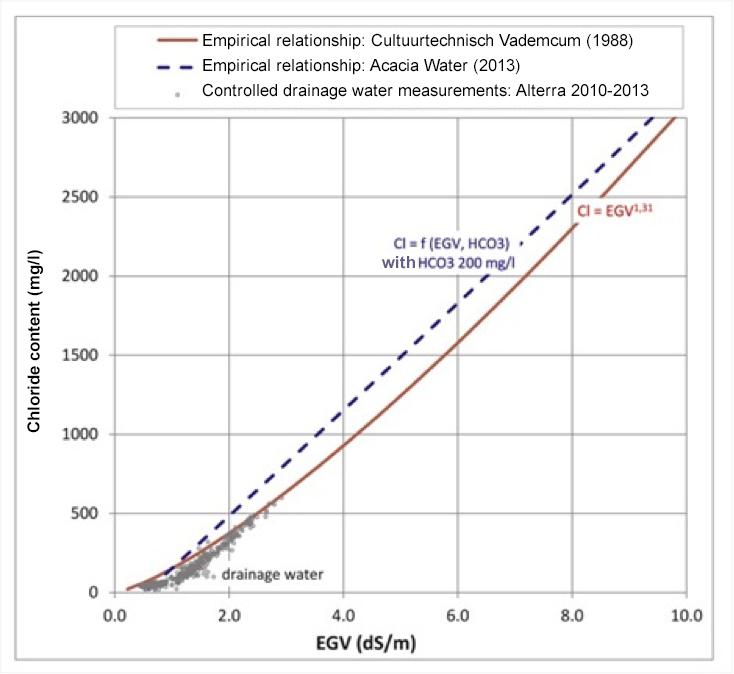
Figure 5. Relationship between EC (dS/m and Chloride (mg/l) (Source: Stuyt et al., 2013).
Van Bakel and Stuyt (2011) have updated the salt tolerance values based on literature, expert knowledge and field experience. They propose using chloride as indicator instead of EC (Figure 5). This is translated by Stuyt et al. (2013) in Table 2.
| Land use according to LGNG | Salt sensitivity class (mg/l Cl) Extremely sensitive | Salt sensitivity class (mg/l Cl) Very sensitive | Salt sensitivity class (mg/l Cl) Sensitive | Salt sensitivity class (mg/l Cl) Moderately sensitive | Salt sensitivity class (mg/l Cl) Moderately tolerant | Salt sensitivity class (mg/l Cl) Tolerant |
| Agrarian grass | 2400 | |||||
| Corn | 600 | |||||
| Potatoes | 600 | |||||
| Beets | 2400 | |||||
| Grains | 1200 | |||||
| Other crops | 300 | |||||
| Greenhouse horticulture | 75 | |||||
| Orchards | 600 | |||||
| Flower bulbs ('Ploegman') | 300 | |||||
| Flower bulbs ('Van der Valk') | 600 | |||||
| Tree nurseries | 150 | |||||
| Fruit nurseries | 300 |
Table 2.Classification of sensitivities to salt based on LGN6 land use categories (all classifications are taken from Van Bakel et al., (2011), except tree nurseries and greenhouse horticulture (source: Stuyt et al., 2013). Figures represent the damage thresholds: the names next to Flower bulbs refer to the researcher who has established the threshold value.
Currently active projects and research
Research related to water management and salt tolerance
On the initiative of STOWA, a new method is being developed to determine the direct and indirect agricultural damage from drought, wet conditions and salt concentrations. The new methodology will replace methods such as AGRICOM, HELP and TCGB (Bartholomew et al., 2013). The new methodology should be suited to the effects of water management, climate and salinity scenarios. In addition, research will be conducted into the applicability of saltwater crops at various locations in the Netherlands.
Research related to crop and salt tolerance
In northern Netherlands, research is underway into various saltwater crops under the banner ‘The Saline Perspective’ and the ‘Saline Knowledge Circle’. When the genetic factors associated with salt tolerance in a halophyte are known, this knowledge can be used to increase the salt tolerance of other crops. From this perspective, research was carried out within Knowledge for Climate (Jeuken et al., 2012) into the mechanisms in the gene expression that account for salt tolerance in glasswort, spinach, beet and quinoa. In addition to universities and research institutes, growers were also involved in this field of research; in Zeeland, for example, Potato Meijer BV, ZLTO and the provincial council of Zeeland set up pilot sites in Zierikzee and Rilland to study in depth the salt tolerance of different potato varieties.
Knowledge gaps
The most common method of determining the salt content of irrigation water is to measure its electrical conductivity (EC). The result is then converted to the chloride content, the standard criterion applied in the Netherlands to determine the risk of salt damage to crops (Figure 5). The conversion factor of EC to chloride concentration lacks consistency, as it does not take into account the ionic composition, the total salt concentration and the water temperature.
The conversion method applied by water managers is not standardised. Moreover, the chloride content is not an ideal indicator, because aside from osmotic effects, salt damage, specifically due to high concentrations of the Na+ ion, can also be a determining factor. These effects include toxic effects and possible structural degradation of the clay soil. Although the sodium/chloride ratio in seawater is relatively constant, the same cannot be said of soil moisture retention.
Little is known about the dynamics of salt tolerance of crops during cultivation, and while there is a better understanding of the mechanism of salt tolerance, much remains to be learned about when and where this tolerance occurs or shifts. How long does it take for a plant to adapt? What does the root do: preferential uptake because roots extract more water from soil layers where fresh water is held or does the root system accept certain concentrations? Plant physiological research is needed to increase understanding and deliver results that are important for crop variables (irrigation, drainage depth, land preparation).
Few data are available to quantify the rate of damage caused by saline irrigation water that is produced from irrigating the aboveground part of the crop with saline water. For the time being, the study is focused on the effect of saline irrigation water on root uptake. More knowledge is also required regarding the effects of salt on soil structure. Structural soil degradation leads to poor water supply for the crop and thus to yield reduction. In addition, damage can also occur in the form of quality loss. Where flower bulbs are concerned, for example, quality has nothing to do with how many kilograms of bulbs are produced, but with the number of bulbs per hectare and how ‘beautiful’ the flowers are. Research into the effects of elevated salt concentration in this area is limited.
Salt tolerance standards should be further supported by Dutch field experiments for more crops, varieties and different salt concentrations and their dynamics.
Salt uptake by crops should be determined in order to establish conclusive balances.
Overview currently active projects and research
| Research Project (including hyperlink) | Parties involved | Contact person | Research location |
| Zeeuwse Tong (through 2013) | Ministry of Economic Affairs, Agriculture and Innovation, Grontmij, Hogeschool Zeeland, Prov. Zeeland, WUR, ZLTO | Jan.Ketelaars@wur.nl; Greet.blom@wur.nl | Colijnsplaat |
| Zeekool | VU Amsterdam, Wageningen UR, HH Hollands Noorderkwartier, Province of Noord- Holland | Arjen de Vos | Texel |
| ZiltPerspectief | Stichting Zilt Perspectief, Vrije Universiteit Amsterdam, Wageningen UR – PRI, Louis Bolk Instituut | Marc van Rijsselberghe | Texel |
| WaterWijzer Landbouw | STOWA, KWR, Wageningen UR, Bakelse Stroom | Mirjam Hack-ten Broeke | NL |
| GoFresh | See website | See website Gualbert Oude Essink | Zeeland |
| KvK-projecten | See website | See website | NL |

 English resume
English resume